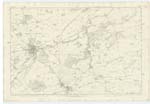OS1/13/58/39
| List of names as written | Various modes of spelling | Authorities for spelling | Situation | Description remarks |
|---|---|---|---|---|
| Site of ENCAMPMENT (Queen Regent's Army 1559) [Wemyss Hall] | Site of the Royal Encampment 1559 Site of the Royal Encampment 1559 |
Thomas Shaw Esqr. Cupar Thomas Galloway Farmer Cupar |
011 | [situation] About 1 3/8 miles N.W. [North West] from Wemyss Hall. The site of the forces of Mary of Guise under the command of the Duke of Chattelrault. is supposed to extend from the two mile stone on the Garlie Bank, (of the road leading from Cupar to Kirkcaldy) to the offices of Edenwood, and almost parallel to the Eden. After pitching their tents, they commenced to make all necessary arrangements for action; on the morning of the 13th June 1559; so as to cut down the rebels who wished to upset the state church, and to carry on their religious ceremonies as the Bible and their conscience dictated. Both armies were ready for action when the Duke Chattelrault, seeing his army far inferior to those of the Lords of the Congregation, sent a messenger to propose an armistice. They, unwilling to risk an action complied, and the principal men in both armies repaired to the Garlie Bank, the highest part of which, somewhat about the two mile stone, they are supposed to have met and signed that truce, and from that point they were able to command a fine view of both armies ready for battle. This site was pointed out by Thomas Shaw Esqr. Writer, and Mr. Galloway. Farmer, both of whom have been long resident in this district. Their definition of it is corroborated by the tradition of the country. |
Continued entries/extra info
39 Parish of Ceres Plan 11C Trace 4[Quotation]
"Along the slope of this hill, under the duke of [Chatelherault and M. D'Oyeel], lay at one time the army which was intended by Mary of Guise to crush the efforts of the reformers. On the opposite bank were stationed those who had determined to die rather than that popery should longer lord it over the conscience of men; and on this hill, where we now stand, the treaty was subscribed which, though soon broken through by the queen-regent, gave time to the reformers, and ultimately led to the establishment of the Presbyterian religion in Scotland" Fullarton's Gazetteer of Scotland Vol I [Volume 1] p. 289.
Transcribers who have contributed to this page.
MaxInSpain
Location information for this page.
Linked mapsheets.




